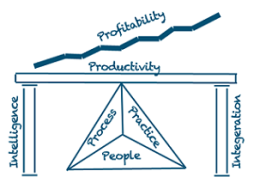5 Steps on How to Achieve Hyper-productivity in a Team
December 19, 2011 7 Comments
Over the years software development has become more sophisticated to help evolve Agile Methodologies. Today it is understood that productivity of agile teams is 25 to 50 per cent higher than teams that follow traditional waterfall software development model. But it will alarm you if I say that there are studies done by Dr. Jeff Sutherland which show that some agile teams are 400 to 800 per cent more productive than their traditional counterparts! So, what are these teams doing different that makes them hyper-productive? Here are 5 steps which an ardent agile follower would agree with:
1. Using Scrum
It has been touted over and over that a scrum team scores much better in productivity over the traditional waterfall approach to software development. Scrum is an agile framework used for project management which actually increases the velocity of the software development.
For those who are a bit unfamiliar…

Image Courtesy: http://www.en.wikipedia.org
Scrum is not a methodology but a type of framework or skeleton for a set of activities which implement Agile Methodologies. Scrum has a product owner (or the stakeholders) which creates a list of prioritized activities also commonly known as product backlog. During planning a sprint backlog is created by pulling out a chunk of prioritized activity from the product backlog. The team then decides on how to implement the prioritized activity. This is done during a certain amount of time also known as the sprint. A sprint is generally for 2-3 weeks. But many teams practice daily scrum too, where they meet every day to assess the progress. At the end of a sprint the team has a deliverable product to the customer. This entire process is monitored by ScrumMaster (which plays the role of a project manager) to keep the team focused on the target.
The entire cycle repeats itself as iterations until all the backlogs are cleared.
The whole process is based on the assumption that there will be an effective team collaboration (with implicit healthy team chemistry,) and the team will be efficient to turn inputs into desired outputs within the time line defined by the product owner (customer). The team will brainstorm and mutually come out with the most efficient ways of coding. Now if is this is true, then what can stop the team from being hyper-productive?
2. Communicate and collaborate often
Implementing and using Agile Project Management with Scrum enforces frequent communication and collaboration with the teams. But using Scrum alone will not lead to hyper-productivity. The teams need to be self-driven and collaborate to get the sprint backlogs done within a sprint. A clear definition of requirements at the start of iteration will ensure that the collaborative efforts are for jotting down steps for development work, so that the sprint backlog (a part of the project) is “done” at the end of the iteration.
3. Engineering Practices
Again, coming back to the point of achieving hyper-productivity level, hyper-productivity is not achieved by just rolling out the Scrum in your organization. It needs certain other practices by the team members, which gives the break-through performances in team productivity.
According to a study published in Gantthead (Shriver, R., April 26, 2010, “Hyper-productive Agile”) on whether scrum leads to hyper-productivity, teams which are self-disciplined and continuously stick to practices decided (maybe informally specific to various projects), demonstrate hyper-productivity vis-à-vis those teams who just follow Scrum-by-the-book. One of the important practices is to implement engineering procedures, such as, automatically creating new builds that pass all the test cases, automating developer-written tests, and automating QA-written tests that are based on automated regression to ensure new changes do not break any previous functionality.
4. Self-Organization
Self-organization is perhaps the simplest practice to state but most underestimated practice. Self-organization can not only improve productivity in software development, it can lead you to achieve break through results in any goal of your life. In project management, it requires the cross-functional teams to collectively focus and commit on highest priority product backlog. The team collectively completes it in the most efficient manner and pairs it immediately to the testing before moving to the next in stack in the product backlog. This collaborative approach ensures that the various prioritized backlogs are completed within sprints and this leads to hyper-productivity.
5. Build Team Chemistry
Another important ingredient of teams achieving hyper-productivity is healthy team chemistry among the teammates. The very fundamental of using Scrum framework is that the team members should be able to collaborate positively, exuberate positive vibes and intelligently work together towards removing obstacles and redundancies which could cause potential slowdown in project velocity. To ensure healthy team chemistry, you should ensure that all the team members are trained in agile methodologies, so as to work collectively within a sprint and achieve “done” software at the end of single iteration.
What is your take? We would love to hear your version.
